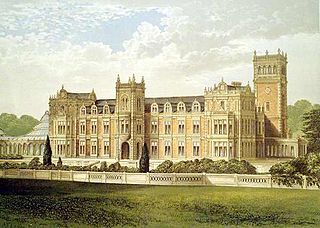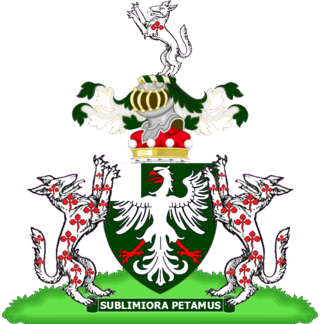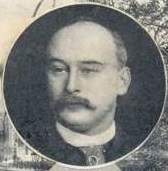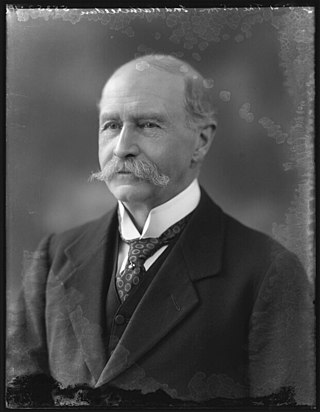Arms
  |
|
Baron Marchamley, of Hawkestone in the County of Salop, is a title in the Peerage of the United Kingdom. [1] It was created in 1908 for the Liberal politician George Whiteley, who had previously represented Stockport and Pudsey in the House of Commons. As of 2014 [update] the title is held by his great-grandson, the fourth Baron, who succeeded his father in 1994.
The Conservative politician Sir Herbert Huntington-Whiteley, 1st Baronet, was the younger brother of the first Baron.
The heir apparent is the present holder's son, the Hon. Leon Whiteley (b. 2004)
  |
|
This article includes a list of general references, but it lacks sufficient corresponding inline citations .(November 2018) |

Marquess of Linlithgow, in the County of Linlithgow or West Lothian, is a title in the Peerage of the United Kingdom. It was created on 23 October 1902 for John Hope, 7th Earl of Hopetoun. The current holder of the title is Adrian Hope.

Viscount Scarsdale, of Scarsdale in Derbyshire, is a title in the Peerage of the United Kingdom. It was created in 1911 for the prominent Conservative politician and former Viceroy of India George Curzon, 1st Baron Curzon of Kedleston, who was created Earl Curzon of Kedleston at the same time and was later made Marquess Curzon of Kedleston.

Viscount Devonport, of Wittington in the County of Buckingham, is a title in the Peerage of the United Kingdom. It was created on 22 June 1917 for the Liberal politician and former Member of Parliament for Devonport, Hudson Kearley, 1st Baron Devonport. He had already been created a Baronet, of Wittington in the Parish of Medmenham in the County of Buckingham on 22 July 1908, and Baron Devonport, of Wittington in the County of Buckingham, on 15 July 1910. As of 2017 the titles are held by his grandson, the third Viscount, who succeeded his father in 1973.

Baron Faringdon, of Buscot Park in the County of Berkshire, is a title in the Peerage of the United Kingdom. It was created in 1916 for Sir Alexander Henderson, 1st Baronet, who had previously represented Stafford West and St George's, Hanover Square in the House of Commons as a Liberal Unionist. He had already been created a baronet in 1902. He was succeeded by his grandson, the second Baron. He was the son of the Hon. Harold Henderson, eldest son of the first Baron, who predeceased his father. Lord Faringdon was a member of the London County Council. As of 2017 the titles are held by his nephew, the third Baron, who succeeded in 1977. He is the son of the Hon. Michael Thomas Handerson, second son of the Hon. Harold Henderson.

Baron Glenconner, of The Glen in the County of Peebles, is a title in the Peerage of the United Kingdom. It was created in 1911 for Sir Edward Tennant, 2nd Baronet, who had earlier represented Salisbury in the House of Commons as a Liberal and also served as Lord Lieutenant of Peeblesshire. Lord Glenconner was succeeded by his second son, the second baron. The latter was succeeded in 1983 by his eldest son, the third baron, who bought the island of Mustique. As of 2014, the titles are held by the third baron's grandson, the fourth baron, who became the next-to-youngest peer in the realm when he succeeded in August 2010.
Baron Gainford, of Headlam in the County Palatine of Durham, is a title in the Peerage of the United Kingdom. It was created on 3 January 1917 for the Liberal politician Jack Pease, a member of the Darlington Pease family. He notably served as President of the Board of Education from 1911 to 1915. Pease was the second son of Sir Joseph Pease, 1st Baronet, and the grandson of Joseph Pease, while Arthur Pease was his uncle and Sir Arthur Pease, 1st Baronet, Beaumont Pease, 1st Baron Wardington, and Herbert Pease, 1st Baron Daryngton, were his first cousins. The third baron was a former member of the London County Council and of the Greater London Council. As of 2013 the title is held by his younger brother, the fourth baron, an architect and town planner; County Planning Officer for Ross and Cromarty 1967–1975 and Scottish Office Inquiry Reporter 1978–1993.
Baron Gisborough, of Cleveland in the County of York, is a title in the Peerage of the United Kingdom. It was created in 1917 for the Conservative politician Richard Chaloner, who had previously represented Westbury and Abercromby in the House of Commons. Born Richard Long, the son of Richard Penruddocke Long, he had assumed by royal licence the surname of Chaloner in lieu of Long in 1881, as a condition of inheriting the Guisborough estate and Gisborough Hall from his maternal great-uncle, Admiral Thomas Chaloner. The latter was a descendant through his mother of Robert de Brus, who founded Gisborough Priory in 1119. Lord Gisborough's eldest son and heir, Richard Godolphin Hume Long Chaloner, was accidentally killed in France in 1917 while guarding German prisoners of war, and is buried at Calais. Lord Gisborough was therefore succeeded by his second son, the second Baron. As of 2011, the title is held by the latter's son, the third Baron, who succeeded in 1951. He notably served as Lord Lieutenant of Cleveland from 1981 to 1996. The title remains strongly linked with the town of Guisborough.

Baron Somerleyton, of Somerleyton in the County of Suffolk, is a title in the Peerage of the United Kingdom. It was created on 26 June 1916 for the Liberal Unionist politician and former Paymaster General Sir Savile Crossley, 2nd Baronet. The titles are currently held by his great-grandson, the fourth Baron, who succeeded his father in 2012.

Baron Phillimore, of Shiplake in the County of Oxford, is a title in the Peerage of the United Kingdom. It was created in 1918 for the former Judge of the High Court of Justice and Lord Justice of Appeal, Sir Walter Phillimore, 2nd Baronet. The Phillimore Baronetcy, of The Coppice, had been created in the Baronetage of the United Kingdom on 28 December 1881 for his father Sir Robert Phillimore, who was also a noted lawyer and judge. The first Baron was succeeded by his son, the second Baron.

Baron Biddulph, of Ledbury in the County of Hereford, is a title in the Peerage of the United Kingdom. It was created on 1 August 1903 for the banker and politician Michael Biddulph. He was a partner in the London banking firm of Cocks, Biddulph and Co and also sat in the House of Commons for Herefordshire as a Liberal from 1868 to 1885 and for Ross from 1885 to 1900 as a Liberal Unionist. His father Robert Biddulph had previously represented Hereford in Parliament while his younger brother Sir Robert Biddulph was Governor of Gibraltar. As of 2017 the title is held by the first Baron's great-great-grandson, the fifth Baron, who succeeded his father in 1988. In 1978 he assumed the additional surname of Maitland, which is the maiden surname of his mother, Lady Mary Helena Maitland, granddaughter of Ian Colin Maitland, 15th Earl of Lauderdale. She is a Patroness of the Royal Caledonian Ball.
Baron Crawshaw, of Crawshaw in the County Palatine of Lancaster and of Whatton in the County of Leicester is a title in the Peerage of the United Kingdom. It was created on 25 August 1892 for Sir Thomas Brooks, 1st Baronet. He notably served as High Sheriff of Lancashire in 1884. Brooks had already been created a baronet in the Baronetage of the United Kingdom, of Crawshaw Hall and Whatton House, on 9 February 1891. As of 2013 the titles are held by his great-grandson, the fifth Baron, who succeeded his elder brother in 1997.
Baron Cawley, of Prestwich in the County Palatine of Lancaster, is a title in the Peerage of the United Kingdom. It was created in 1918 for the Liberal politician Sir Frederick Cawley, 1st Baronet. He had previously represented Prestwich in the House of Commons and served as Chancellor of the Duchy of Lancaster from 1916 to 1918. Before his elevation to the peerage, Cawley had been created a baronet, of Prestwich in the County Palatine of Lancaster, in the Baronetage of the United Kingdom, in 1906. His grandson, the third Baron, notably served as Deputy Chairman of Committees in the House of Lords from 1958 to 1967. As of 2023 the titles are held by the latter's eldest son, the fourth Baron, who succeeded in 2001.
Baron Clwyd, of Abergele in the County of Denbigh, is a title in the Peerage of the United Kingdom. It was created in 1919 for the Liberal politician Sir John Roberts, 1st Baronet, who had previously represented Denbighshire West in the House of Commons. He had already been created a Baronet, of Brynwenallt in the parish of Abergele in the County of Denbigh, in the Baronetage of the United Kingdom in 1908. Lord Clwyd's father John Roberts had earlier been Member of Parliament for Flint from 1878 to 1892. As of 2016 the titles are held by his great-grandson, the fourth Baron, who succeeded his father in 2006.

Baron Ritchie of Dundee, of Welders in the Parish of Chalfont St Giles in the County of Buckingham, is a title in the Peerage of the United Kingdom. It was created in 1905 for the Conservative politician Charles Ritchie. He was Home Secretary between 1900 and 1902 and Chancellor of the Exchequer between 1902 and 1903.
Baron Rathcavan, of The Braid in the County of Antrim, is a title in the Peerage of the United Kingdom. It was created on 11 February 1953 for the Unionist politician Sir Hugh O'Neill, 1st Baronet. He had already been created a Baronet, of Cleggan in the County of Antrim, on 17 June 1929. O'Neill was the third son of Edward O'Neill, 2nd Baron O'Neill and the uncle of the Prime Minister of Northern Ireland Terence O'Neill, Baron O'Neill of the Maine. Lord Rathcavan was also a male-line descendant of Edward Chichester, 1st Viscount Chichester. He was succeeded by his eldest surviving son, the second Baron. He succeeded his father as Unionist Member of Parliament for Antrim in 1952, a seat he held until 1959, and was later a member of the Parliament of Northern Ireland. As of 2014 the titles are held by his son, the third Baron, who succeeded in 1994.
Baron Ravensdale, of Ravensdale in the County of Derby, is a title in the Peerage of the United Kingdom.

George Whiteley, 1st Baron Marchamley PC was a British Conservative turned Liberal Party politician. He served as Chief Whip between 1905 and 1908 in the Liberal administrations of Sir Henry Campbell-Bannerman and H. H. Asquith.

Cecil William Norton, 1st Baron Rathcreedan was a British Liberal Party politician.
Baron Dunleath, of Ballywalter in the County of Down, is a title in the Peerage of the United Kingdom. It was created on 29 August 1892 for the businessman and former Conservative Member of Parliament for Downpatrick, John Mulholland. The Mulholland family were involved in the cotton and linen industry in Ulster in the north of Ireland. The first Baron's son, the second Baron, represented Londonderry North in the House of Commons as a Conservative. His grandson, the fourth Baron, was a member of the Northern Ireland Assembly for the Alliance Party. He was succeeded by his first cousin, the fifth Baron, who had already succeeded his father as second Baronet of Ballyscullion. As of 2017 the titles are held by the fifth Baron's son, the sixth Baron, who succeeded in 1997.

Earl of Arran is a title in the Peerage of Ireland. It is not to be confused with the title Earl of Arran in the Peerage of Scotland. The two titles refer to different places: the Aran Islands in Ireland, and the Isle of Arran in Scotland. The Irish earldom is held by the Gore family. The Scottish earldom is a separate title, held as a subsidiary title of the Duke of Hamilton.